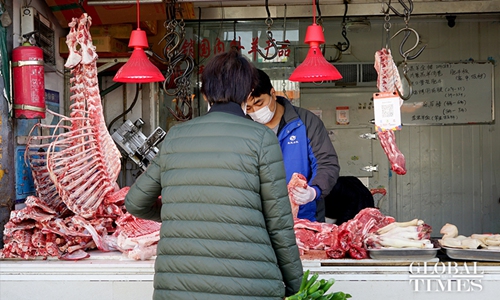HOME >> SOURCE
Digital coupons stimulate China’s consumption, boost economic recovery
By Shen Weiduo Source:Global Times Published: 2020/4/5 19:33:16

Photo: Chen Xia/GT
More local authorities in China have been scaling up efforts to distribute digital vouchers in recent days, a move economists said could not only inject fresh momentum to the country’s yet-to-recover offline businesses, but could also rapidly stimulate the consumption demand of local residents – who are still reluctant to spend outside, though the domestic virus situation has abated.
Nevertheless, while encouraging nationwide vouchers distribution, experts cautioned that the move is just a first step that could serve as a short-term bailout to restart the country’s businesses in the special period. A full consumption recovery will still depend on a more comprehensive top-down policy stimulus, and most importantly when the virus dies.
Amid the Qingming Festival from Saturday to Monday, the country’s first official holiday since the COVID-19 outbreak, more cities and provinces across the country have used digital vouchers.
From Saturday to June 30, Qingdao in East China’s Shandong Province said it will release about 3.65 million digital coupons. The coupons, which range from 10 yuan to 100 yuan, could be used in convenience stores, restaurants, department stores and culture and tourism sectors across the city.
Meanwhile, Shenzhen’s Luohu district in South China’s Guangdong Province said it would issue 30 million yuan worth of digital consumption vouchers to residents in the city starting April 2, and Shenzhen residents who consume in Luohu district could use the vouchers.
Authorities of the district said they’ve also prepared another 10 million yuan budget for merchants who participate in the event, and those who reached a similar operation situation same time last year would be awarded 100,000 yuan.
In East China’s Jiangxi Province, 20 million yuan in catering digital vouchers have also been distributed in the province starting Saturday.
So far across the country, more than 30 cities such as Nanjing in East China’s Jiangsu Province, and Hangzhou and Ningbo in East China’s Zhejiang Province have launched consumer coupons ranging from several million yuan to hundreds of millions of yuan, according to a report from Economic Daily on Saturday.
Ways of acquiring the vouchers is also powered by technology backed by the country’s internet giants such as Alibaba and Tencent. Based on local demands, Tencent said it can customize digital coupons in different denominations and distribute them to designated industries, and users can automatically obtain them when paying.
Tencent told the Global Times on Sunday that it has partnered with authorities in Qingdao, Central China’s Hunan Province, Southwest China’s Chongqing Municipality and East China’s Zhejiang Province to distribute different digital vouchers covering different industries according to different demands.
Different consumption vouchers distribution policies, which are customized based on the peculiar situation of different areas, are targeted and quite effective in rapidly “restarting the offline businesses” that had been hit hard by the pandemic, Wang Jun, a member of the academic committee at the China Center for International Economic Exchanges and chief economist at Zhongyuan Bank, told the Global Times on Sunday.
Consumers would also be encouraged to spend outside as soon as possible by the vouchers as they usually have an expiration date. A white-collar worker surnamed Liu based in Shenzhen told the Global Times on Sunday that she has already spent the 80-yuan digital voucher on Saturday at a restaurant, as the voucher is only good for seven days.
“I’m waiting for the second wave distribution,” Liu said, adding that the voucher could be used in almost all shops in the city if paid online, including restaurants and department stores.
According to media reports, the first round of digital coupons distributed in Hangzhou, which has already cashed a government subsidy of 94.1 million yuan ($13.27 million), has so far driven consumption worth 1.25 billion yuan in the city.
To further promote offline consumption, authorities in Hangzhou said it released the second round of digital coupons on Friday, and expected the effect to be “more obvious.”
Wang also expects more cities and provinces to join the effort, and called for a more “targeted distribution” to low-income and vulnerable groups, noting that the voucher policy could be distributed in batches with priorities for different target groups and covering more sectors such as auto, education and home decor.
However, Wang cautioned that the amounts of vouchers issued are still not that “big” and are mainly limited on the local level instead of a nationwide effort, with the impact on the whole country and its GDP still to come.
“The vouchers will only encourage people to take the first step. It’s a combination of fiscal and monetary policy and other stimulus measures that could push the world’s second-largest economy back on a fast track,” Wang said.
Posted in: ECONOMY